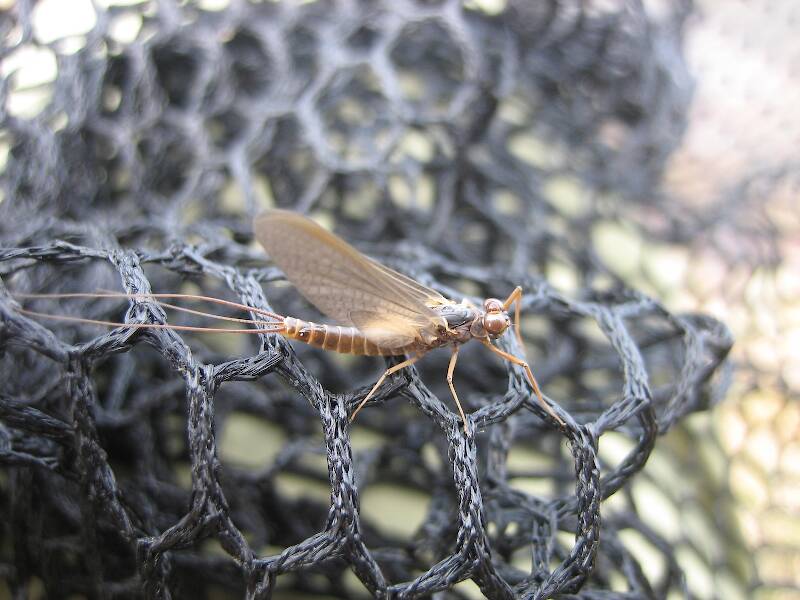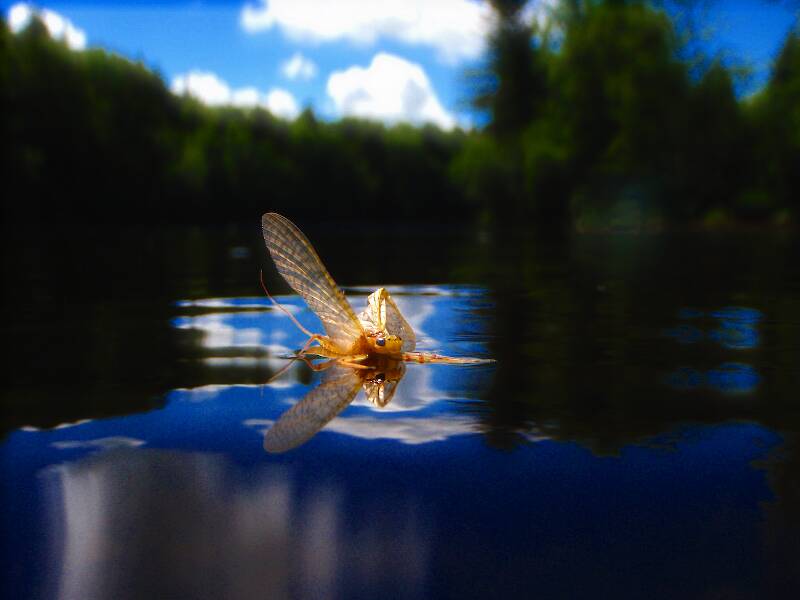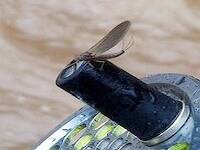
Hex Mayflies
Hexagenia limbata
The famous nocturnal Hex hatch of the Midwest (and a few other lucky locations) stirs to the surface mythically large brown trout that only touch streamers for the rest of the year.
Featured on the forum

This is the first of it's family I've seen, collected from a tiny, fishless stream in the Cascades. The three species of this genus all live in the Northwest and are predators that primarily eat stonefly nymphs Merritt R.W., Cummins, K.W., and Berg, M.B. (2019).

Troutnut is a project started in 2003 by salmonid ecologist Jason "Troutnut" Neuswanger to help anglers and
fly tyers unabashedly embrace the entomological side of the sport. Learn more about Troutnut or
support the project for an enhanced experience here.

Al514 on May 5, 2007May 5th, 2007, 3:46 pm EDT
ID please! Fish were hitting these all day. I'm in the northeast.
Taxon on May 5, 2007May 5th, 2007, 5:22 pm EDT
AI514-
Nice photo. My guess would be Paraleptophlebia, perhaps P. adoptiva.
Nice photo. My guess would be Paraleptophlebia, perhaps P. adoptiva.
JAD on May 6, 2007May 6th, 2007, 12:54 am EDT
Good picture ,fine quality I agree. (Adoptiva.)
john
john
They fasten red (crimson red) wool around a hook, and fix onto the wool two feathers which grow under a cock’s wattles, and which in colour are like wax.
Radcliffe's Fishing from the Earliest Times,
Troutnut on May 6, 2007May 6th, 2007, 6:43 pm EDT
Nice picture -- that's a striking mayfly!
I'm not so sure about P. adoptiva. All of those I've caught (at least, all I think were that species) had unmarked slate gray wings without such dark veins.
Leptophlebiidae does seem right. I'm really busy now or I would try to narrow it down more.
I'm not so sure about P. adoptiva. All of those I've caught (at least, all I think were that species) had unmarked slate gray wings without such dark veins.
Leptophlebiidae does seem right. I'm really busy now or I would try to narrow it down more.
Jason Neuswanger, Ph.D.
Troutnut and salmonid ecologist
Troutnut and salmonid ecologist
Quillgordon on May 7, 2007May 7th, 2007, 12:49 am EDT
Al......
Very nice photo........ I need a camera!
Taxon.....
Jason is questioning you ???.... LOL........
Is the 'honeymoon over' ????? Hmmmmm
Just stirring the pot ! LOL
John.....
Nice picture -- that's a striking mayfly!
Very nice photo........ I need a camera!
Taxon.....
I'm not so sure about P. adoptiva. All of those I've caught (at least, all I think were that species) had unmarked slate gray wings without such dark veins.
Jason is questioning you ???.... LOL........
Is the 'honeymoon over' ????? Hmmmmm
Just stirring the pot ! LOL
John.....
Flyfishing is a state of mind! .............. Q.g.
C/R........barbless
C/R........barbless
Troutnut on May 7, 2007May 7th, 2007, 1:02 am EDT
Okay, now that I've got a little more time to confirm my instinct that it just doesn't quite "look" like Paraleptophlebia, I checked Arbona's book on Mayflies to verify one of the characteristics that was bugging me: the middle tail is shorter than the outer ones. That means Leptophlebia rather than Paraleptophlebia. (Unless it's some more obscure genus in that family like Choroterpes, about which I have no identification information handy.)
Jason Neuswanger, Ph.D.
Troutnut and salmonid ecologist
Troutnut and salmonid ecologist
Taxon on May 7, 2007May 7th, 2007, 4:31 pm EDT
Mea culpa, Leptophlebia makes sense.
Quillgordon on May 8, 2007May 8th, 2007, 12:19 am EDT
Looking at the photo of Jason's L.cupida( the old 'Blasturus cupidas, love that name, why did they change it)........
.... shouldn't the eyes and legs be 'blackish' not brown?
.....wings... they look more 'bluish gray than 'grayish brown'
@ Ref: 'Matching the Hatch', E. Schwiebert,Jr., pg.41,48.
* I see the middle tail is shorter( may be broken ?)
** It just doesn't seem that the colors( noted above) are correct!
Just asking...
.... shouldn't the eyes and legs be 'blackish' not brown?
.....wings... they look more 'bluish gray than 'grayish brown'
@ Ref: 'Matching the Hatch', E. Schwiebert,Jr., pg.41,48.
* I see the middle tail is shorter( may be broken ?)
** It just doesn't seem that the colors( noted above) are correct!
Just asking...
Flyfishing is a state of mind! .............. Q.g.
C/R........barbless
C/R........barbless
Troutnut on May 8, 2007May 8th, 2007, 4:17 am EDT
Yeah, I kind of doubt it's L. cupida too. But there are many other species of Leptophlebia. That's why I'd like to catch some to photograph for my site; they're probably a species I don't have yet.
Jason Neuswanger, Ph.D.
Troutnut and salmonid ecologist
Troutnut and salmonid ecologist
Taxon on May 8, 2007May 8th, 2007, 1:45 pm EDT
NY Leptophlebia are L. bradleyi, L. cupida, L. johnsoni, and L. nebulosa. Absence of dark forelegs probably eliminates L. cupida. Based on wing venation and tail markings, it could be L. johnsoni, but who knows.
Quillgordon on May 9, 2007May 9th, 2007, 1:43 am EDT
NY Leptophlebia are L. bradleyi, L. cupida, L. johnsoni, and L. nebulosa. Absence of dark forelegs probably eliminates L. cupida. Based on wing venation and tail markings, it could be L. johnsoni, but who knows.
Taxon..... I was counting on you to know! ..........Rats!
OK..... I feel a little better!
Cheers!
Flyfishing is a state of mind! .............. Q.g.
C/R........barbless
C/R........barbless
Troutnut on May 18, 2007May 18th, 2007, 11:05 am EDT
It's either L. cupida or L. nebulosa. Apparently L. johnsoni has a middle tail as long as or longer than the outer tail. L. bradleyi is ruled out by the size and the depth of the median notch on abdominal segment 9 on my female spinner. I think the apparent darkness of the legs may just depend on the lighting, because my specimens do have darker fore legs.
Unfortunately I can't tell which of these two species it is, because the darn key for female spinners requires that I have a ball of eggs to tell them apart.
Here are the two specimens, both females, that I collected after going to this same creek a couple days after Al514:
http://www.troutnut.com/specimen/710
http://www.troutnut.com/specimen/711
Unfortunately I can't tell which of these two species it is, because the darn key for female spinners requires that I have a ball of eggs to tell them apart.
Here are the two specimens, both females, that I collected after going to this same creek a couple days after Al514:
http://www.troutnut.com/specimen/710
http://www.troutnut.com/specimen/711
Jason Neuswanger, Ph.D.
Troutnut and salmonid ecologist
Troutnut and salmonid ecologist
Quick Reply
Related Discussions
Topic
Replies
Last Reply
4
Dec 22, 2009
by Oldredbarn
by Oldredbarn
0
Dec 18, 2011
by Martinus
by Martinus
8
Jun 16, 2013
by PaulRoberts
by PaulRoberts
11
Feb 26, 2008
by Taxon
by Taxon






